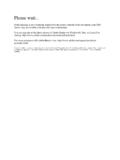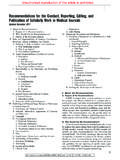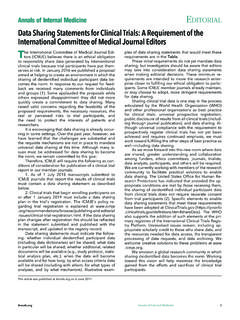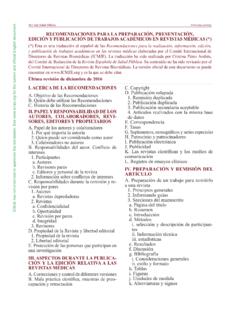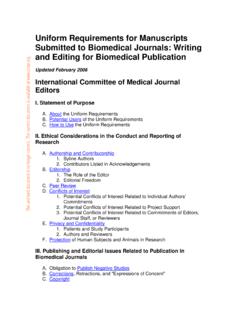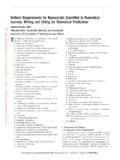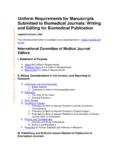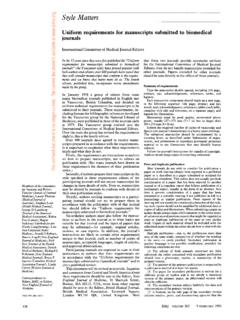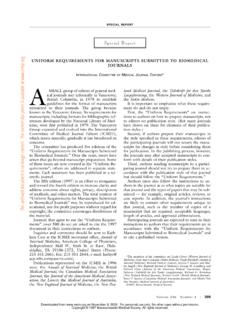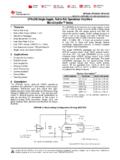Transcription of International Committee of Medical Journal …
1 International Committee of Medical Journal Editors I. Statement of Purpose A. About the Uniform Requirements B. Potential Users of the Uniform Requirements C. How to Use the Uniform Requirements II. Ethical Considerations in the Conduct and Reporting of Research A. Authorship and Contributorship 1. Byline Authors 2. Contributors Listed in Acknowledgements B. Editorship 1. The Role of the editor 2. Editorial Freedom C. Peer Review D. Conflicts of Interest 1. Potential Conflicts of Interest Related to Individual Authors' Commitments 2. Potential Conflicts of Interest Related to Project Support 3. Potential Conflicts of Interest Related to Commitments of Editors, Journal Staff, or Reviewers E. Privacy and Confidentiality 1.
2 Patients and Study Participants 2. Authors and Reviewers F. Protection of Human Subjects and Animals in Research III. Publishing and Editorial Issues Related to Publication In Biomedical Journals A. Obligation to Publish Negative Studies B. Corrections, Retractions, and "Expressions of Concern" This archived document is no longer current. The current document is available at Copyright D. Overlapping Publications 1. Duplicate Submission 2. Redundant Publication 3. Acceptable Secondary Publication 4. Competing Manuscripts based on the Same Study a. Differences in Analysis or Interpretation b. Differences in Reported Methods or Results 5. Competing Manuscripts Based on the Same Database E. Correspondence F.
3 Supplements, Theme Issues, and Special Series G. Electronic Publishing H. Advertising I. Medical Journals and the General Media J. Obligation to Register Clinical Trials IV. Manuscript Preparation and Submission A. Preparing a Manuscript for Submission to Biomedical Journals 1. a. General Principles b. Reporting Guidelines for Specific Study Designs 2. Title page 3. Conflict of Interest Notification Page 4. Abstract and Key Words 5. Introduction 6. Methods a. Selection and Description of Participants b. Technical Information This archived document is no longer current. The current document is available at Statistics 7. Results 8. Discussion 9. References a. General Considerations Related to References b.
4 Reference Style and Format 10. Tables 11. Illustrations (Figures) 12. Legends for Illustrations (Figures) 13. Units of Measurement 14. Abbreviations and Symbols B. Sending the Manuscript to the Journal V. References A. Print References Cited in this Document B. Other Sources of Information Related to Biomedical Journals VI. About the International Committee of Medical Journal Editors VII. Authors of the Uniform Requirements VIII. Use, Distribution, and Translation of the Uniform Requirements IX. Inquiries I. Statement Of Purpose I. A. About the Uniform Requirements A small group of editors of general Medical journals met informally in Vancouver, British Columbia, in 1978 to establish guidelines for the format of manuscripts submitted to their journals.
5 The group became known as the Vancouver Group. Its requirements for manuscripts, including formats for bibliographic references developed by the National Library of Medicine, were first published in 1979. The Vancouver Group expanded and evolved into the International Committee of Medical Journal Editors (ICMJE), which meets annually. The ICMJE gradually has broadened its concerns to include ethical principles related to publication in This archived document is no longer current. The current document is available at journals. The ICJME has produced multiple editions of the Uniform Requirements for Manuscripts Submitted to Biomedical Journals. Over the years, issues have arisen that go beyond manuscript preparation, resulting in the development of a number of Separate Statements on editorial policy.
6 The entire Uniform Requirements document was revised in 1997; sections were updated in May 1999 and May 2000. In May 2001, the ICMJE revised the sections related to potential conflict of interest. In 2003, the Committee revised and reorganized the entire document and incorporated the Separate Statements into the text. The Committee prepared this revision in 2004. The total content of the Uniform Requirements for Manuscripts Submitted to Biomedical Journals may be reproduced for educational, not-for-profit purposes without regard for copyright; the Committee encourages distribution of the material. Journals that agree to use the Uniform Requirements are encouraged to state in their instructions to authors that their requirements are in accordance with the Uniform Requirements and to cite this version.
7 Potential Users of the Uniform Requirements The ICMJE created the Uniform Requirements primarily to help authors and editors in their mutual task of creating and distributing accurate, clear, easily accessible reports of biomedical studies. The initial sections address the ethical principles related to the process of evaluating, improving, and publishing manuscripts in biomedical journals and the relationships between editors and authors, peer reviewers, and the media. The latter sections address the more technical aspects of preparing and submitting manuscripts. The ICMJE believes the entire document is relevant to the concerns of both authors and editors. The Uniform Requirements can provide many other stakeholders peer reviewers, publishers, the media, patients and their families, and general readers with useful insights into the biomedical authoring and editing process.
8 I. C. How to Use the Uniform Requirements The Uniform Requirements state the ethical principles in the conduct and reporting of research and provide recommendations relating to specific elements of editing and writing. These recommendations are based largely on the shared experience of a moderate number of editors and authors, collected over many years, rather than on the results of methodical, planned investigation that aspires to be evidence-based. Wherever possible, recommendations are accompanied by a rationale that justifies them; as such, the document serves an educational purpose. Authors will find it helpful to follow the recommendations in this document whenever possible because, as described in the explanations, doing so improves the quality ity and clarity of reporting in manuscripts submitted to any Journal , as well as the ease of editing.
9 At the same time, every Journal has editorial requirements uniquely suited to its purposes. Authors therefore need to become familiar with the specific This archived document is no longer current. The current document is available at to authors published by the Journal they have chosen for their manuscript for example, the topics suitable for that Journal , and the types of papers that may be submitted (for example, original articles, reviews, or case reports) and should follow those instructions. The Mulford Library at the Medical College of Ohio maintains a useful compendium of instructions to authors. II. Ethical Considerations in the Conduct and Reporting of Research Authorship and Contributorship Byline Authors An author is generally considered to be someone who has made substantive intellectual contributions to a published study, and biomedical authorship continues to have important academic, social, and financial implications.
10 (1) In the past, readers were rarely provided with information about contributions to studies from those listed as authors and in acknowledgments. (2) Some journals now request and publish information about the contributions of each person named as having participated in a submitted study, at least for original research. Editors are strongly encouraged to develop and implement a contributorship policy, as well as a policy on identifying who is responsible for the integrity of the work as a whole. While contributorship and guarantorship policies obviously remove much of the ambiguity surrounding contributions, it leaves unresolved the question of the quantity and quality of contribution that qualify for authorship. The International Committee of Medical Journal Editors has recommended the following criteria for authorship; these criteria are still appropriate for those journals that distinguish authors from other contributors.
